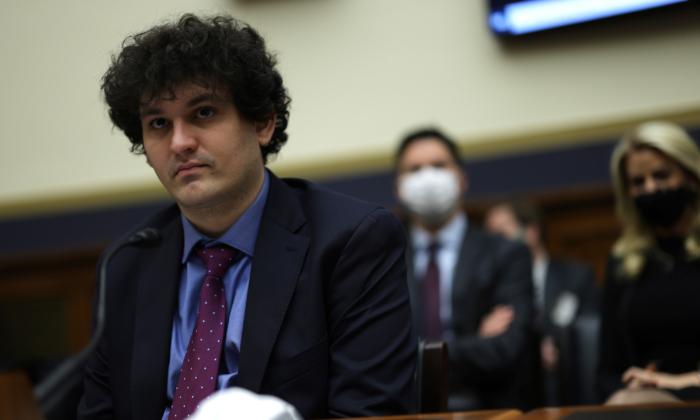The collapse of FTX isn’t just another crypto scam gone bust due to changed market prices. In its brief life of three years, stretching from 2019 to 2022, it became the second-biggest crypto exchange on the planet with billions in venture funding and a million customers.
It also had enormous influence over the direction of American public life, backing and subsidizing the worst policy decisions of public health on record. They included lockdowns, vaccine mandates, and compliance passports that contradict every core principle of freedom.
You could say that all of this is coincidental. Sam Bankman-Fried was just a geek with too much success too fast, and his philanthropy was entirely heartfelt. There’s nothing strange going on here! And it’s true that one can be too conspiratorial.
On the other hand, we shouldn’t be naïve.
At some point, it’s entirely possible that FTX became a money-laundering operation for pro-lockdown psyops. In fact, we can’t rule out that this was part of the raison d’être of the operation from the beginning. Perhaps it was intended to have a short shelf life, transferring billions and manipulating public opinion during the Great Reset, then shutting down.
For these years, it’s been a mystery to me and to many millions of others why there wasn’t more opposition from intellectuals, public health officials, political figures, and nonprofit organizations, even those ostensibly dedicated to civil liberties and freedom. We locked down, and there was this seeming silence. Those of us who wrote to object were isolated and disconnected. We were the extreme minority.
The elites, on the other hand, pretended that all of this was completely normal. Why were we objecting as churches and schools were closed? Why were we spreading disinformation that scrapping the Bill of Rights overnight is a bad idea? Why were we so obsessed with the idea of freedom that we failed to realize that these are all just commonsense health measures?
It took those of us among the dissidents months and even years to find each other. Our legacy communities failed to speak out, and we were forced to wander alone and look for new allies. Meanwhile, the lockdowners and mandaters seemed to have it all together, with Big Media, Big Tech, and the whole of government on their side.
FTX might have played a central role in this, similar to the Gates Foundation, except with fake money made through the crypto racket, even while its founder chose the disguise of working toward a more regulated industry.
The company and its founder and CEO, Bankman-Fried, gave tens of millions to Democrat Party candidates and backed all associated causes, from climate change to pandemic planning. They funded media outlets such as ProPublica, Vox, Intercept, and Semafor, all of whom backed lockdowns and mandates. Even now, The New York Times is hosting Bankman-Fried for an interview this week and charging $2,400 to attend.
Meanwhile, the corporate structure of the company had ballooned beyond belief, with some 300 different divisions and side companies, and it was the same in the philanthropic arm, a network of astonishing complexity. It’s extremely difficult to follow it all, exactly as one might expect from a money-laundering operation.
I’ve spent hours trying to trace it all out based on public records, which are thin but also breadcrumbs from podcasts, blogs, tweets, and listings of staff, scholars, and board members of various nonprofits that seem to come and go and enjoy mysterious funding sources. One gains a picture of a remarkable web of quid pro quo and dark scammery. It would take some serious and deep forensic accounting to figure it all out more clearly, which is something that’s expensive and difficult.
One keeps seeing these strange overlaps of mutual connections between Bankman-Fried, his brother’s nonprofit Guarding Against Pandemics, Protect Our Future, Center for Innovation in Global Health, Center for Health Security, Emergent Ventures/Fast Grants, Future Fund, Institute for Progress, and many other institutions that seem to share funding and priorities. Their podcasts with each other promote and protect, and their tweets tag each other and name specific accounts along the way as interested parties.
It’s all a huge thicket.
Meanwhile, the people associated with all these causes and institutions are all saying that they didn’t know and are as shocked as you and I. Oh, sure.
“We plan to distribute at least $100M this year, and potentially a lot more, depending on how many outstanding opportunities we find. In principle, we’d be able to deploy up to $1B this year,” the announcement reads.
These kinds of numbers make people in academia, media, and the nonprofit world lose their minds. They realize that they can be on the list for funding, provided that they don’t screw up and start protesting the public health response, doubting the brilliance of Fauci, or advocating for the unvaccinated. The point is to play your cards right and get on the list.
In this way, the announcement of possible funding can be as effective a means of control as the funding itself. In light of this, I can’t shake the strong impression I have that FTX and its funding networks account for the massive distortion of the public conversation surrounding COVID-19 controls. One of the major economic blogs touted FTX’s funding scam even while pushing for more lockdowns and smearing critics of lockdowns. It was hardly alone. Essentially, all these venues tended toward a China-style of pandemic control rather than a traditional public health response.
FTX and its networks are the very definition of dark money. Surely many recipients knew this or at least suspected that there might be something funny going on if millions of dollars suddenly arrives from a source that traces to a magic bean factory in the Bahamas as run by a 30-year-old geek whose parents are law professors at Stanford. There’s something implausible about the whole deal, but when cash like that is waved around, it’s easy to let go of one’s incredulity.
How deep does the corruption go? I don’t know the answer, but I’m willing to guess that it goes much deeper. Consider FTX’s connections to Ukraine. Of all exchanges in the world, why did the money managers of Ukraine pick FTX? We’re told that Ukraine didn’t deposit money with FTX but rather only used them to exchange their crypto for dollars. But where exactly did Ukraine get all this crypto? Are we really supposed to believe that this was just philanthropy at work as millions of generous donors the world over were giving to the cause from the goodness of their own hearts?
The timing of the unraveling here also shakes me. FTX was founded in 2019, just soon enough to enter into the public realm on the topic of pandemic controls, and then it disappeared just following the 2022 midterm elections, over which its funding arm had a huge influence, especially in races that were in deep need.
One looks at all of this unfolding with a sense of amazement. We’re being told it was all on the up and up, no real funny business, just a bright student having gotten carried away. Meanwhile, Bernie Madoff was arrested within hours after the revelations of his Ponzi scheme, and Elizabeth Holmes is going to prison. It seems like FTX managed its payoffs pretty well because even as I type, Bankman-Fried is refashioning himself as a public pundit.
Keep in mind, too, that FTX might only be the tip of the iceberg. During the pandemic years, governments of the world found the excuse to distribute billions and trillions from taxpayers to well-connected elites, doing it all through the public treasury. Much of it was lost and stolen. Much of it ended up in the hands of people who were up to no good. FTX is thus a window into a world of scammery that’s beyond what the worst cynic of 2019 would have thought possible.
A final note: The bandits absolutely don’t want to be found out. The cover-ups have already begun. There simply aren’t enough investigators on this case. We need answers. Getting them is going to take years.





